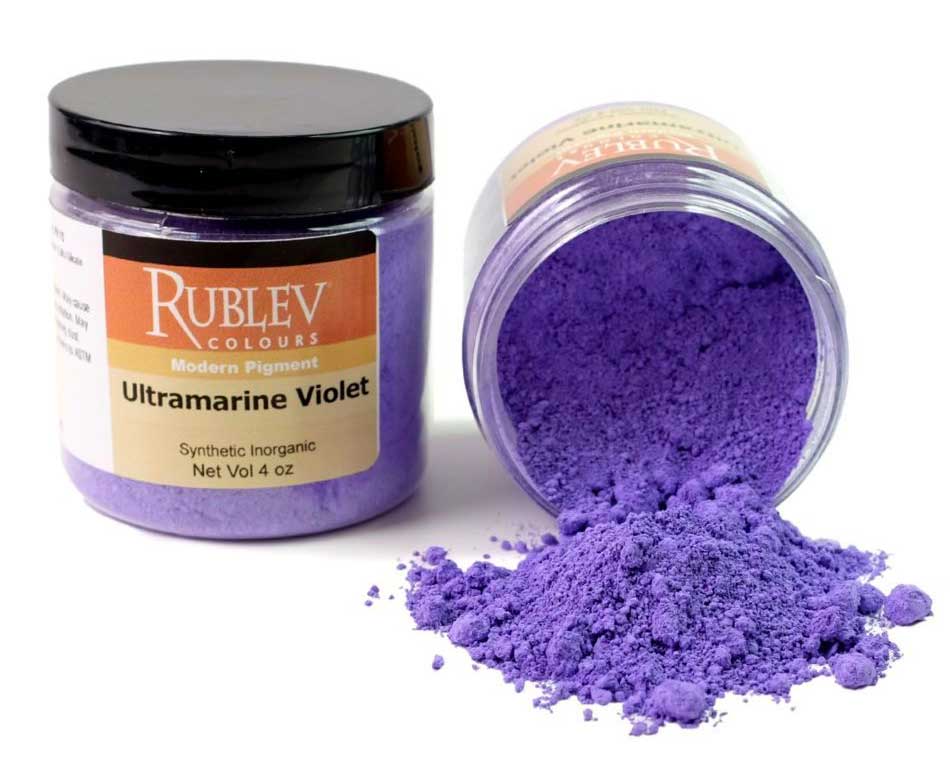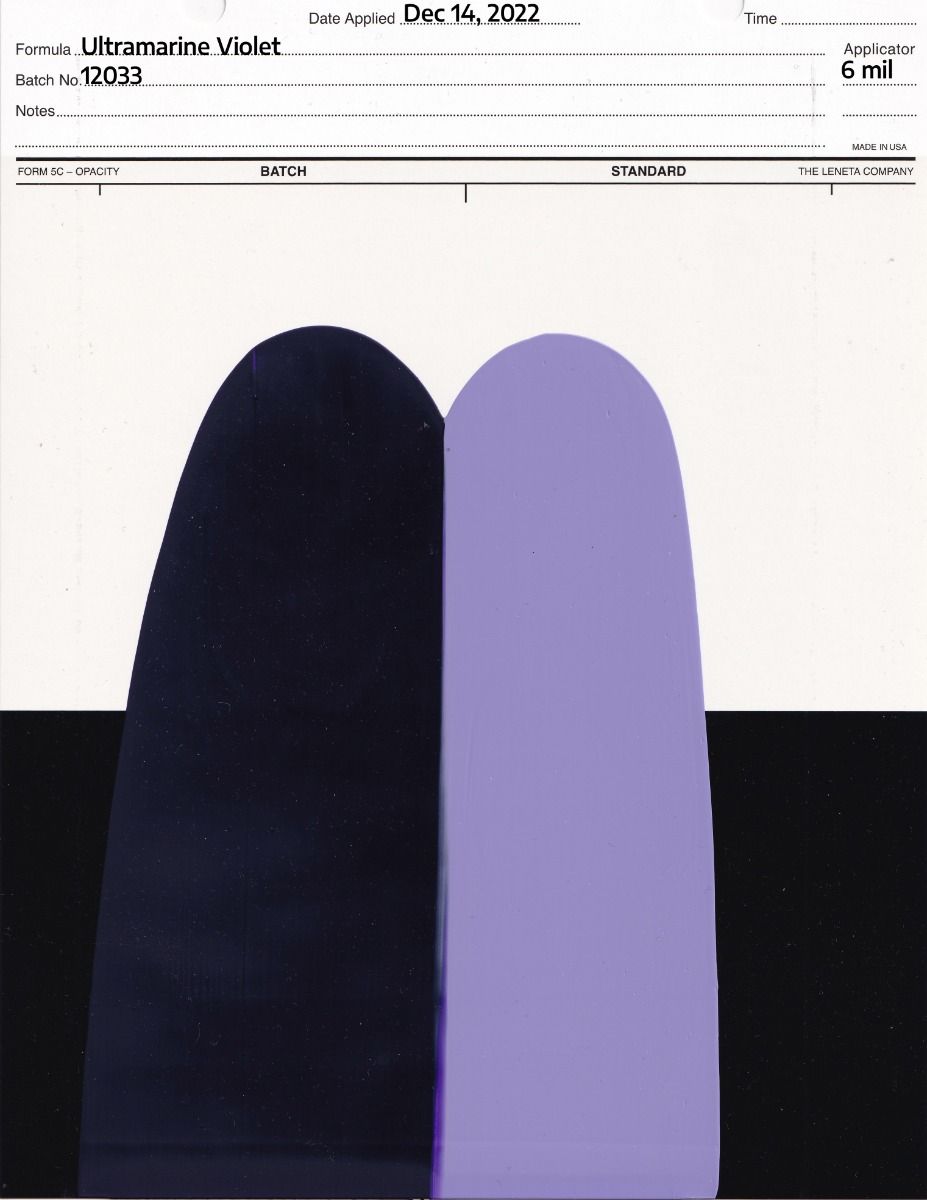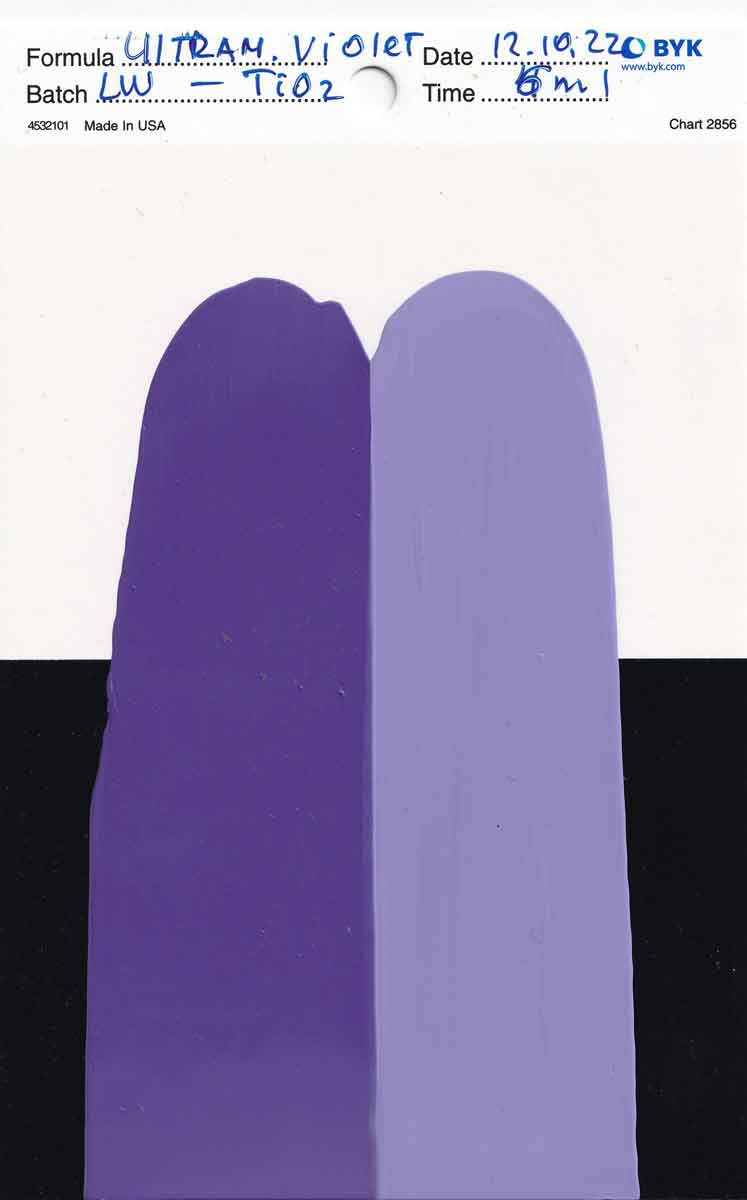
Works of art rarely contained the color violet until the Impressionists in the mid-19th century. A study of the color violet has shown it to be present in only 2% to 4% of the artworks created before the early 1860s. It quickly became very popular soon after that date, rising from 36.5% to 47.9%. What explains the steep increase in the use of violet in paintings in the early 1860s? While the introduction of cheap purple and so-called violet pigments in the 1860s made its use more economical for artists, this alone does not explain the trends. According to the same study of the color violet, an increased sensitivity to violet colors due to the continuous evolution of the human visual system offers an alternative explanation. In addition, the contemporary developments in color theory and their adoption by Impressionist painters may almost naturally have led to an increase in the use of violet from 1863 onwards.
One of the violet colors on the artist's palette is ultramarine violet. Ultramarine violet (Colour Index Pigment Violet 15 or PV 15) is a synthetic inorganic pigment used in painting for over a century. The pigment is known for its intense, deep violet color and has been used in a variety of painting styles and mediums. Ultramarine violet is derived from ultramarine blue (Colour Index Pigment Blue 29 or PB 29)—a pigment with similar properties known for its deep blue color. In this article, we will explore the history, source, origin, chemical composition, properties, compatibility and permanence, toxicity, and use of ultramarine violet in painting and how it differs from ultramarine blue.
Ultramarine Violet offers a unique violet shade that is very clean and bright and has the excellent ability to make whites “whiter.” It is semi-transparent to visible light and transparent to Near Infrared (NIR), hence it is deemed a “cool” pigment, but its cool performance is highly dependent on the substrate and type of paint.

Drawdown of ultramarine violet oil paint with full strength on the left and mixed with titanium white at a 1:1 ratio. The thickness of the paint films is 6 mil (0.006 in) or 152.4 micrometers. This is a standard test of opacity and tinting strength.

A comparison of the relative tinting strength of ultramarine violet in mixtures with lead white (left) and titanium white (right) at the same ratio of 1:1. The dramatic difference in tinting strength of these whites with all colors is clearly seen in this drawdown of 6 mils (0.006 in) or 152.4 micrometers thick paint films.
Origin and History
Ultramarine blue has a long history dating back to ancient times. It was originally made from the semi-precious stone lapis lazuli and was considered a rare and valuable pigment. It was not until the 19th century that a synthetic version of ultramarine blue was developed. The origin of ultramarine violet can be traced back to the late 19th century. Ultramarine violet is a variant of ultramarine blue pigment and an intermediate to ultramarine pink. Synthetic ultramarine blue was first developed in the early 19th century, in France, by the chemist Jean-Baptiste Guimet. Guimet was a professor of chemistry at the University of Besançon, and he experimented with various combinations of pigments to create new colors. He discovered that by combining ultramarine blue and pink, he could create a new and intense shade of violet that was more vibrant than any other existing violet pigment. Guimet named the new pigment ultramarine violet. Ultramarine violet was first commercialized by the German chemical company BASF in the early 20th century and quickly gained popularity among artists.
Source of Pigment
Ultramarine violet is a synthetic inorganic pigment, which means it is created by chemical processes rather than being extracted from natural sources. The pigment is typically made by mixing various chemical compounds, including sodium, sulfur, and aluminum. Ultramarine blue is also a synthetic inorganic pigment made by mixing sodium and sulfide compounds. The exact composition of ultramarine violet and blue can vary depending on the manufacturer. Ultramarine violet is made using the same process as ultramarine blue. Ultramarine blue is mixed with about 2.5–5% ammonium chloride, heated to 200–250°C for 24–36 hours, depending on the specific reaction temperature, vessel, and gas circulation, and finally exposed to air until the purple color develops. Other methods are also used to produce ultramarine violet, such as ultramarine blue can be heated with gaseous chlorine at 180°C. Ultramarine violet is an intermediate in the transformation of ultramarine blue to ultramarine pink and contains large quantities of an unidentified pink chromophore.
Chemical Composition
The chemical composition of ultramarine violet is Na8-10[Al6Si6O24S2-4] or Na6+x[AlSiO4]6(S3-,S2-)xSn. It is a complex mineral composed of aluminum, silicon, sodium, and sulfur. The chemical composition of Ultramarine blue is Na6[Al6Si6O24S].
Physical Properties
Ultramarine violet and ultramarine blue have several physical properties that make them attractive pigments for use in painting. Both pigments are highly lightfast, meaning they are resistant to fading or discoloration when exposed to light. Additionally, they have good tinting strength, meaning that a small amount of pigment can achieve a deep, intense color. Ultramarine violet and blue are also insoluble in water and most organic solvents, which makes them stable and resistant to fading or discoloration when exposed to these substances.
Compatibility and Permanence
Ultramarine violet and blue are both very stable pigments and compatible with a wide variety of painting mediums. They can be used in oil, acrylic, and watercolor paints and in printmaking inks, pastels, and other art materials. They are also considered permanent pigments, meaning they will not degrade or change color over time. Ultramarine violet is rated by the American Society of Testing and Materials (ASTM International) as lightfastness category I, which is the highest lightfastness. It is compatible with all pigments and resists alkalis but has poor acid resistance. Like ultramarine blue, it should not be used in acidic environments such as outdoors.
Oil Absorption and Grinding
Ultramarine violet absorbs a moderate amount of oil (34 to 37 grams per 100 grams of pigment) and hence is a moderately fast-drying oil color. This means that the pigment absorbs less oil to make a stiff paste, resulting in a lower oil content by the weight of the paint. This can be beneficial, as it can help to reduce the amount of drying time required for the paint. It disperses well in both oil- and water-based paints and is easy to mull by hand into a smooth paste.
Toxicity
Ultramarine violet and blue are both considered to be non-toxic pigments, making them safe for use in painting. The pigment is not water-soluble and is therefore not absorbed into the body when ingested. The pigment is non-irritating to the skin and is not known to cause any adverse health effects. However, caution should be exercised when handling the dry powder pigment to avoid inhalation, which can cause irritation to the lungs.
Conclusion
In conclusion, Ultramarine violet is a synthetic inorganic pigment that has been used in painting for over a century. It is known for its intense, deep violet color and has been used in a variety of painting styles and mediums. It is a stable and permanent pigment with good tinting strength, lightfastness, and compatibility with various mediums. It is also considered non-toxic, but it should be handled with care as it can cause irritation if it comes into contact with the skin or eyes.
Pigment Information
| Pigment Information | |
| Color: | Violet |
| Colour Index: | Pigment Violet 15 (77007) |
| Chemical Name: | Sodium Aluminum Sulfosilicate |
| Chemical Formula: | Na8-x[(Al,Si)12]O24(Sy)2 |
| ASTM Lightfastness Rating | |
| Acrylic: | I |
| Oil: | I |
| Watercolor: | I |
| Properties | |
| Specific Gravity: | 2.35 |
| Oil Absorption: | 34–37 grams oil / 100 grams pigment |
| Particle Size D90: | ≤ 4 micron |
| Particle Size D100: | ≤ 44 micron |
| Tap Density: | 0.50–0.55 g/cc |
| Free Sulphur (maximum): | 0.01% by weight |
| Soluble Salts: | 0.7% by weight |
| Moisture Content: | 0.05% by weight |
| Munsell Notation: Ultramarine Violet Oil | |||
| Hue | Value | Chroma | |
| Masstone: | 8.6 PB | 2.2 | 1.3 |
| With Titanium White: | 1.0 P | 6.0 | 5.7 |
| With Lead White: | 1.1 P | 3.8 | 6.3 |
Natural Pigments provides the Munsell Color Notation according to the Munsell Color System using a spectrophotometer and visual interpretation. To gain a better understanding of this color system, refer to The Munsell Book of Color, published by the Munsell Color Corporation, or other literature that discusses the Munsell theory, or go to www.munsell.com.
Color Notes: Ultramarine Violet
Ultramarine Violet Oil Color
References
-
Tager, A, Kirchner, E, Fedorovskaya, E. “Computational evidence of first extensive usage of violet in the 1860s.” Color Res Appl. 2021; 46: 961– 977. https://doi.org/10.1002/col.22638
-
Kremer Pigmente. “Ultramarine Violet, Pigment Violet 15, Synthetic Ultramarine.” Kremer Pigmente, n.d. Web. 18 Jan 2023.
-
Mendoza, E., Weyrich, P., & Herrero-Albillos, J. (2020). “A Brief History of Ultramarine Violets.” In Modern Pigments and Their Applications. Springer, Cham. 1–16.
-
Guimet, J.B. (1819). “Nouvelles méthodes pour la préparation des pigments.” Annales de Chimie et de Physique, 14, 175-181.
-
Levene, D. (2015). “Ultramarine Violet." In D. Levene (Ed.), Pigment Compendium: A Dictionary of Historical Pigments. Oxford, UK: Butterworth-Heinemann.
-
Meller, J. (2019). Ultramarine Violet: A Comprehensive Guide. Retrieved from https://www.jamesmillerfineart.com/blog/ultramarine-violet-a-comprehensive-guide
-
Wyszecki, G. & Stiles, W. S. (2000). Color Science: Concepts and Methods, Quantitative Data and Formulae (2nd ed.). Hoboken, NJ: John Wiley & Sons.
-
National Gallery of Art (2020). Pigments Through the Ages: Ultramarine Violet. Retrieved from https://www.nga.gov/features/slideshows/pigments-through-the-ages-ultramarine-violet.html
-
National Gallery of Art (2020). Pigments Through the Ages: A Brief History of Pigment Development. Retrieved from https://www.nga.gov/features/slideshows/pigments-through-the-ages-a-brief-history-of-pigment-development.html
-
Royal Society of Chemistry (2020). Ultramarine Violet. Retrieved from https://www.rsc.org/periodic-table/element/33/ultramarine-violet
-
Smithsonian Institution (2020). Pigments and Paints: Ultramarine Violet. Retrieved from https://www.si.edu/spotlight/pigments-and-paints/ultramarine-violet











